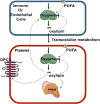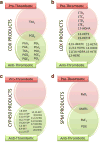The expansive role of oxylipins on platelet biology
- PMID: 28528513
- PMCID: PMC5547901
- DOI: 10.1007/s00109-017-1542-4
The expansive role of oxylipins on platelet biology
Abstract
In mammals, three major oxygenases, cyclooxygenases (COXs), lipoxygenases (LOXs), and cytochrome P450 (CYP450), generate an assortment of unique lipid mediators (oxylipins) from polyunsaturated fatty acids (PUFAs) which exhibit pro- or anti-thrombotic activity. Over the years, novel oxylipins generated from the interplay of theoxygenase activity in various cells, such as the specialized pro-resolving mediators (SPMs), have been identified and investigated in inflammatory disease models. Although platelets have been implicated in inflammation, the role and mechanism of these SPMs produced from immune cells on platelet function are still unclear. This review highlights the burgeoning classes of oxylipins that have been found to regulate platelet function; however, their mechanism of action still remains to be elucidated.
Keywords: Cyclooxygenase; Eicosanoids; Lipoxygenase; Oxygenases; Prostaglandins; Thrombosis.
Figures






Similar articles
-
Oxidation of polyunsaturated fatty acids to produce lipid mediators.Essays Biochem. 2020 Sep 23;64(3):401-421. doi: 10.1042/EBC20190082. Essays Biochem. 2020. PMID: 32618335 Free PMC article. Review.
-
Pathological and pharmacological functions of the metabolites of polyunsaturated fatty acids mediated by cyclooxygenases, lipoxygenases, and cytochrome P450s in cancers.Pharmacol Ther. 2024 Apr;256:108612. doi: 10.1016/j.pharmthera.2024.108612. Epub 2024 Feb 16. Pharmacol Ther. 2024. PMID: 38369063 Review.
-
Advances in Our Understanding of Oxylipins Derived from Dietary PUFAs.Adv Nutr. 2015 Sep 15;6(5):513-40. doi: 10.3945/an.114.007732. Print 2015 Sep. Adv Nutr. 2015. PMID: 26374175 Free PMC article. Review.
-
The Biosynthesis of Enzymatically Oxidized Lipids.Front Endocrinol (Lausanne). 2020 Nov 19;11:591819. doi: 10.3389/fendo.2020.591819. eCollection 2020. Front Endocrinol (Lausanne). 2020. PMID: 33329396 Free PMC article. Review.
-
Bioactive lipid regulation of platelet function, hemostasis, and thrombosis.Pharmacol Ther. 2023 Jun;246:108420. doi: 10.1016/j.pharmthera.2023.108420. Epub 2023 Apr 24. Pharmacol Ther. 2023. PMID: 37100208 Free PMC article. Review.
Cited by
-
The Plasma Oxylipin Signature Provides a Deep Phenotyping of Metabolic Syndrome Complementary to the Clinical Criteria.Int J Mol Sci. 2022 Oct 2;23(19):11688. doi: 10.3390/ijms231911688. Int J Mol Sci. 2022. PMID: 36232991 Free PMC article.
-
Eicosanoids in inflammation in the blood and the vessel.Front Pharmacol. 2022 Sep 27;13:997403. doi: 10.3389/fphar.2022.997403. eCollection 2022. Front Pharmacol. 2022. PMID: 36238558 Free PMC article. Review.
-
Collection and Storage of Human Plasma for Measurement of Oxylipins.Metabolites. 2021 Feb 26;11(3):137. doi: 10.3390/metabo11030137. Metabolites. 2021. PMID: 33652624 Free PMC article.
-
COVID-19 infection alters kynurenine and fatty acid metabolism, correlating with IL-6 levels and renal status.JCI Insight. 2020 Jul 23;5(14):e140327. doi: 10.1172/jci.insight.140327. JCI Insight. 2020. PMID: 32559180 Free PMC article.
-
Lipidomic analysis of differently prepared platelet concentrates in additive solution during storage.Blood Transfus. 2023 Sep;21(5):409-421. doi: 10.2450/2022.0144-22. Epub 2022 Nov 4. Blood Transfus. 2023. PMID: 36346879 Free PMC article.
References
-
- Mozaffarian D, Benjamin EJ, Go AS, Arnett DK, Blaha MJ, Cushman M, de Ferranti S, Despres JP, Fullerton HJ, Howard VJ, et al. Heart disease and stroke statistics—2015 update: a report from the American Heart Association. Circulation. 2015;131:e29–322. - PubMed
-
- Jackson SP. Arterial thrombosis—insidious, unpredictable and deadly. Nat Med. 2011;17:1423–1436. - PubMed
-
- Chandrasekharan JA, Marginean A, Sharma-Walia N. An insight into the role of arachidonic acid derived lipid mediators in virus associated pathogenesis and malignancies. Prostaglandins Other Lipid Mediat. 2016;126:46–54. - PubMed
Publication types
MeSH terms
Substances
Grants and funding
LinkOut - more resources
Full Text Sources
Other Literature Sources

